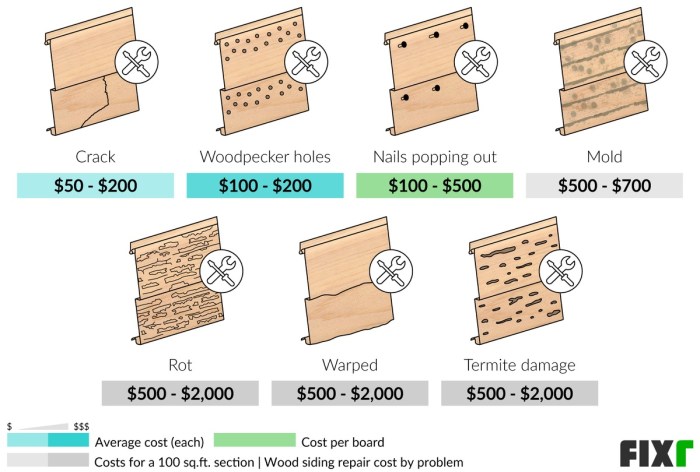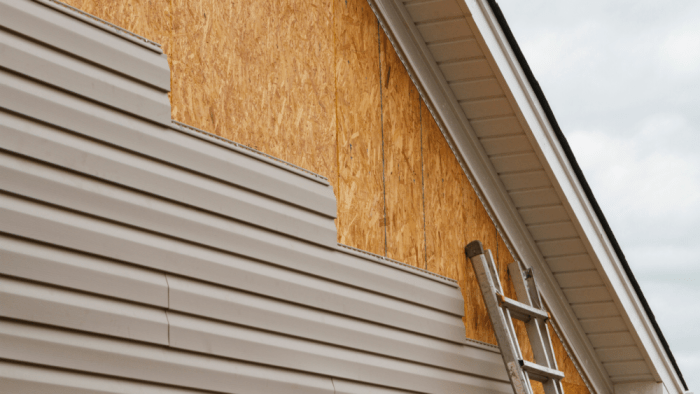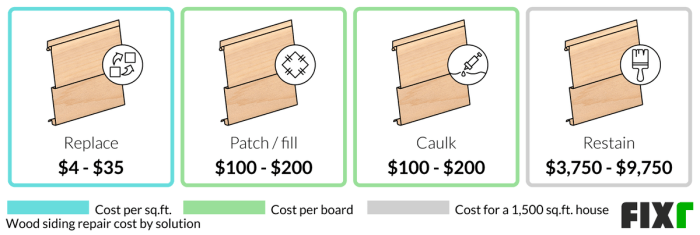Replacing Wood Siding Cost: Factors, Types, and Comparisons
Exploring the cost of replacing wood siding delves into various factors that influence pricing, types of materials available, and comparisons with other siding options. This comprehensive guide aims to provide valuable insights for those considering a siding replacement project.
When it comes to home improvement projects, understanding the cost implications of replacing wood siding is crucial. From material choices to long-term savings, this detailed analysis covers it all.
Factors Affecting Cost of Replacing Wood Siding
When considering the cost of replacing wood siding, several factors come into play that can influence the overall price of the project.
Size of the Project
The size of the project is a major factor that affects the cost of replacing wood siding. Larger homes or buildings will require more materials and labor, resulting in higher overall costs. The square footage of the area to be covered with new siding directly impacts the total expenses.
Type and Quality of Wood Siding Chosen
The type and quality of wood siding chosen will also impact the pricing. Different types of wood siding come at varying price points, with high-quality materials costing more than standard options. Factors such as durability, maintenance requirements, and aesthetic appeal can all influence the overall cost.
Additional Costs to Consider
In addition to the cost of materials, there are several other expenses to consider when replacing wood siding. Labor costs for installation, permits required by local authorities, and fees for disposal of old siding materials can all add to the total price of the project.
It is important to factor in these additional costs to ensure an accurate budget for the replacement project.
Types of Wood Siding Materials
Wood siding offers a classic and natural look to homes, but there are various types of wood siding materials available for replacement. Each type comes with its own set of pros and cons in terms of durability, cost, and maintenance requirements.
Cedar Siding
- Pros:Cedar is naturally resistant to rot, decay, and insects, making it durable and long-lasting. It also offers a beautiful, natural aesthetic.
- Cons:Cedar siding can be more expensive upfront compared to other wood siding materials. It requires regular maintenance, such as staining or painting, to preserve its appearance and protect it from the elements.
Pine Siding
- Pros:Pine is a more affordable option for wood siding. It can be easily painted or stained to achieve the desired look.
- Cons:Pine is less durable than cedar and may be more prone to rot and insect damage. It requires more frequent maintenance to prevent issues like warping or cracking.
Redwood Siding
- Pros:Redwood is known for its natural beauty and resistance to decay and insects. It is a durable option that can last for many years with proper maintenance.
- Cons:Redwood siding tends to be more expensive than other wood siding materials. It also requires regular maintenance to preserve its appearance and protect it from the elements.
Cypress Siding
- Pros:Cypress is a durable wood siding material that is resistant to rot, decay, and insects. It offers a unique aesthetic with natural variations in color and grain.
- Cons:Cypress siding can be more expensive upfront. It requires regular maintenance, such as sealing or staining, to prolong its lifespan and maintain its appearance.
Comparing Costs

Wood siding is a popular choice for homeowners, but it's essential to consider the cost implications compared to other siding materials like vinyl, fiber cement, or metal. Each material has its own set of pros and cons, which can impact the initial cost as well as long-term maintenance expenses.
Wood Siding vs. Vinyl Siding
Vinyl siding is known for its affordability and low maintenance requirements
Wood Siding vs. Fiber Cement Siding
Fiber cement siding is a durable and low-maintenance alternative to wood siding. Although fiber cement siding may have a slightly higher initial cost, it can provide long-term savings by reducing the need for frequent repairs or replacements associated with wood siding.
Wood Siding vs. Metal Siding
Metal siding is a modern and sleek option that can be cost-competitive with wood siding. While metal siding may have a comparable initial cost to wood siding, it offers excellent durability and requires minimal maintenance, potentially leading to cost savings over time.Choosing wood siding over alternative materials may be a cost-effective choice in scenarios where a traditional and natural aesthetic is desired.
Additionally, in historic preservation projects or areas with strict architectural guidelines, wood siding may be the preferred option despite the potential for higher costs.
Cost-Saving Tips for Replacing Wood Siding

When it comes to replacing wood siding, there are several strategies you can employ to save costs without compromising on quality. Whether you opt for a DIY approach or hire a contractor, there are ways to ensure you get the best value for your money.
Consider DIY Options
If you have some experience with home improvement projects and the right tools, tackling the wood siding replacement as a do-it-yourself project can lead to significant cost savings. By eliminating labor costs, you can allocate more of your budget towards high-quality materials.
However, it's important to assess your skill level and ensure you have the necessary expertise to complete the project successfully.
Negotiate with Contractors
If you decide to hire a contractor for the wood siding replacement, don't be afraid to negotiate on the price. Obtain multiple quotes from different contractors and compare them to ensure you are getting a competitive rate. You can also discuss the possibility of providing your own materials to lower costs or ask for discounts based on the scope of the project.
Building a good rapport with the contractor and being clear about your budget can also help in negotiating a better deal.
Opt for Cost-Effective Materials
Choosing cost-effective wood siding materials can also help in reducing overall expenses. Consider options like engineered wood or composite siding, which offer the look of real wood at a lower price point. While these materials may not have the same longevity as traditional wood siding, they can provide a budget-friendly alternative that still enhances the aesthetic appeal of your home.
Plan Ahead and Minimize Waste
Another cost-saving tip is to plan the project meticulously to minimize waste. By accurately measuring the area to be covered and ordering the right amount of materials, you can avoid unnecessary expenses on excess siding. Additionally, consider salvaging any salvageable wood from the existing siding to reduce the need for new materials.
Regular Maintenance and Upkeep
Lastly, investing in regular maintenance and upkeep of your wood siding can help prolong its lifespan and prevent the need for premature replacement. Simple tasks like cleaning, sealing, and repainting can go a long way in preserving the integrity of your siding and saving you money in the long run.
Closing Notes

In conclusion, the cost of replacing wood siding involves a multitude of considerations, from upfront expenses to maintenance requirements. By weighing these factors carefully, homeowners can make informed decisions that align with their budget and preferences.
General Inquiries
What factors can affect the cost of replacing wood siding?
The size of the project, type and quality of wood siding chosen, as well as additional costs like labor, permits, and disposal fees can impact the overall cost.
What are some common types of wood siding materials used for replacement?
Cedar, redwood, pine, and engineered wood are popular choices with varying durability and cost considerations.
How does the cost of wood siding compare to other materials like vinyl or fiber cement?
Wood siding may have a higher upfront cost but could offer long-term savings in terms of aesthetics and insulation properties.
Are there ways to reduce the cost of replacing wood siding?
DIY options, negotiating with contractors, and exploring cost-saving strategies can help lower expenses without compromising quality.